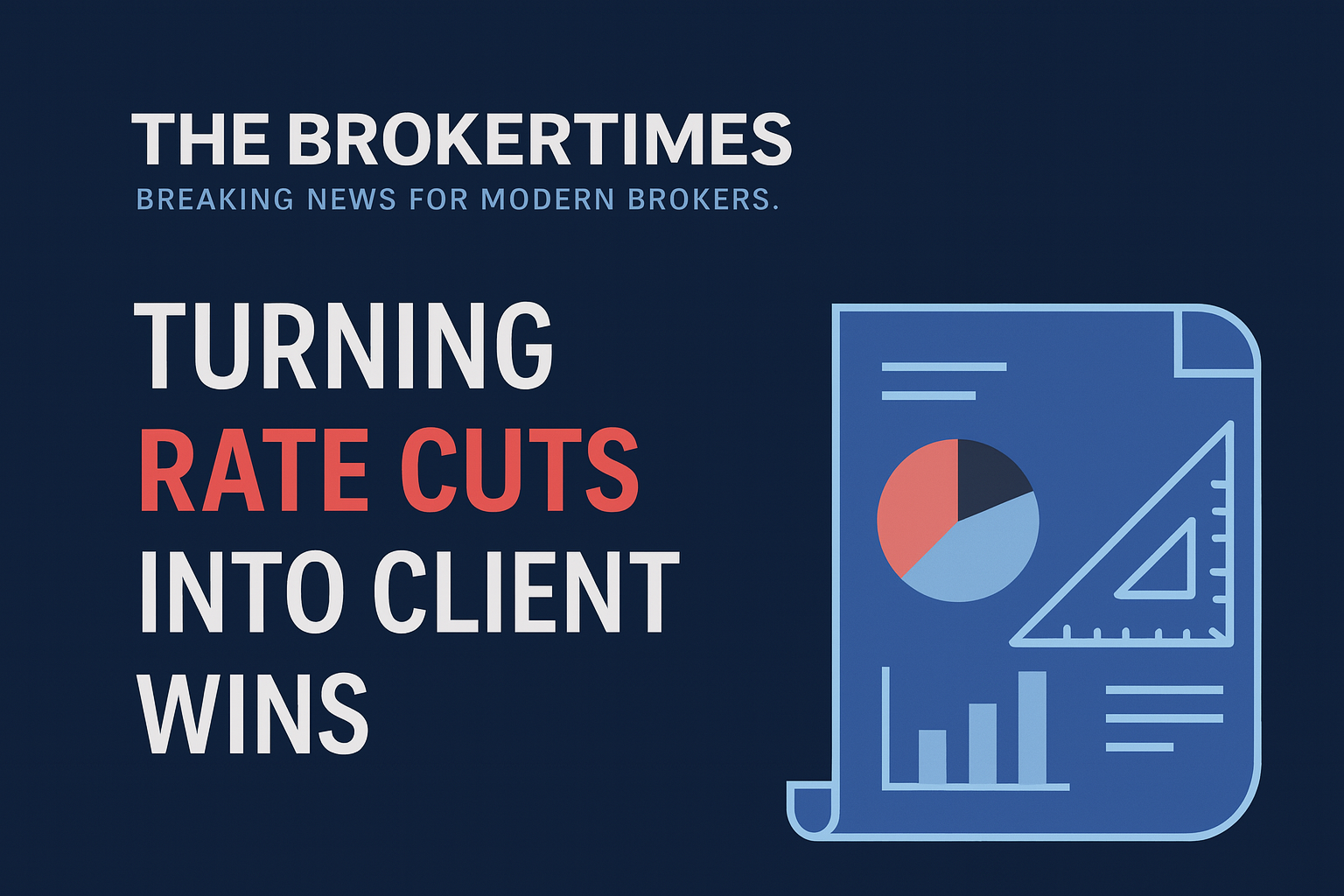Too Busy to Read? We’ve Got You.
Get this blog post’s insights delivered in a quick audio format — all in under 10 minutes.
This audio version covers: The Broker’s Blueprint for 2025 – Turning Rate Cuts into Client Wins
The Broker's Blueprint for 2025: Turning Rate Cuts into Client Wins
The Australian mortgage and property landscape of 2025 is defined by a complex and often contradictory set of forces. For mortgage brokers, navigating this environment requires a level of strategic insight that moves far beyond transactional advice. This report serves as an essential playbook, designed to equip industry professionals with the deep, data-driven analysis and actionable strategies needed to guide clients through the challenges and opportunities of a pivotal year.
The market is in the midst of a clear monetary easing cycle, yet affordability remains at crisis levels. Property prices continue to climb, even as economic growth remains fragile. This creates an "affordability paradox," where the benefits of lower interest rates are being consumed by rising asset values, leaving many aspiring homeowners—particularly those without external support—further behind.
Table of Contents
- The 2025 Macro-Economic Chessboard: A Broker's Briefing
- The Australian Property Market Under Pressure: Navigating the Affordability Paradox
- The Lender Landscape: Competition, Strategy, and Client Advocacy
- The 2025 Client Playbook: Tailored Strategies for Key Segments
- The Broker's Strategic Edge: Synthesising Insights for Proactive Advisory
Section 1: The 2025 Macro-Economic Chessboard: A Broker's Briefing
To provide authoritative advice, brokers must first master the macro-economic context that frames every client conversation and business decision. The lending environment of 2025 is being shaped by the Reserve Bank of Australia's decisive pivot towards monetary easing, a move prompted by a complex interplay of moderating inflation, weak economic growth, and global uncertainty.
1.1 The RBA's Easing Cycle: Rationale and Trajectory
The foundational shift in the 2025 economic landscape was the Reserve Bank of Australia's (RBA) move to an explicit easing cycle. After holding the official cash rate (OCR) at a peak of 4.35% since November 2023, the RBA initiated its first rate cuts since 2020. A 25-basis-point reduction in February 2025 was followed by another in May, bringing the OCR down to 3.85%. This pivot signals a new phase of monetary policy, one that brokers must be able to articulate with nuance and clarity.
Key Insight: The RBA is not just cutting rates from a position of strength on the inflation front; it is also responding to signs of economic fragility. GDP growth has been sluggish, rising by a mere 0.2% in the March quarter 2025, for an annual growth rate of just 1.3%.
1.2 Forecasting the Future: Big Four Consensus vs. Market Speculation
With the RBA clearly in an easing cycle, the central question for brokers and their clients is how far and how fast rates will fall. While there is a firm consensus among Australia's Big Four banks that multiple cuts will occur before the end of 2025, their forecasts diverge on the precise timing and magnitude.
| Forecaster | July 2025 OCR | Year-End 2025 OCR | Key Rationale |
|---|---|---|---|
| CBA | 3.60% | 3.35% | Expects two more cuts in 2025, brought forward to July and August after soft inflation data |
| Westpac | Hold | 3.35% | Sees cuts in August and November, with a more aggressive easing cycle into 2026 (to 2.85%) |
| NAB | 3.60% | 3.10% | The most aggressive of the Big Four, forecasting three more cuts in 2025 due to economic weakness |
| ANZ | Hold | 3.60% | The most conservative, forecasting only one more cut in 2025, reflecting a view of a more resilient economy |
| ASX Market Futures | 3.60% | ~3.05% | Financial markets are pricing in a rapid and deep easing cycle, more aggressive than any major bank |
1.3 Key Economic Indicators: The Data Behind the Decisions
The decisions of the RBA and the forecasts of economists are not made in a vacuum; they are driven by a dashboard of key economic indicators. A broker's ability to speak confidently about this data adds a layer of credibility and authority to their advice.
Critical Economic Metrics:
- Inflation Deep Dive: As of March 2025, headline CPI stood at 2.4% annually, with trimmed-mean inflation at 2.9%. The monthly CPI indicator for May showed a further fall to 2.1%.
- Economic Growth Breakdown: The 0.2% GDP growth in Q1 2025 was below consensus forecasts, driven by sharp slowdown in household consumption.
- Labour Market Nuance: While unemployment remains at 4.1%, the underemployment rate sits at 5.9%, with total labour underutilisation at approximately 10.1%.
Section 2: The Australian Property Market Under Pressure: Navigating the Affordability Paradox
The macroeconomic currents of falling interest rates and fragile growth are flowing directly into the Australian property market, creating a complex and challenging environment. While lower borrowing costs would typically signal a straightforward boom, the market in 2025 is constrained by a deep, structural affordability crisis.
2.1 The Price-Growth Puzzle: A Tale of Two Tiers
Despite significant economic headwinds and stretched household budgets, property prices are forecast to continue their upward trajectory through 2025. The consensus among major forecasters is for national dwelling values to increase, albeit at a more modest pace than the booms of previous years. Projections for national price growth generally fall within a 3% to 6% range for the year.
Market Performance by City:
- Strong Performers: Perth, Adelaide, and Brisbane expected to lead with growth up to 8-10%
- Moderate Growth: Sydney and Melbourne forecast for 3-7% growth
- Key Driver: Interstate migration and relative affordability fueling growth in smaller capitals
2.2 The Great Affordability Squeeze: A Structural Crisis
The backdrop to this price growth is a housing affordability crisis of historic proportions. The key metrics paint a sobering picture for aspiring homeowners and renters alike.
Shocking Statistics: The national dwelling value-to-income ratio has reached a record high of 8.0. It now takes an average of 10.6 years for a typical household to save a 20% deposit. The national average for a 20% deposit is $134,841, rising to $156,761 in New South Wales.
2.3 The Paradox of Lower Rates: More Debt, Same Hurdle
This is the central paradox that brokers must master to effectively advise clients in 2025. On the surface, lower interest rates should improve housing affordability. However, in the current market, they are having a counterintuitive effect, particularly for first home buyers.
The Affordability Paradox Formula:
Lower Rates → Higher Borrowing Capacity → Increased Competition → Higher Prices → Same (or Worse) Affordability
A seemingly modest 0.5% reduction in the cash rate can boost an individual's borrowing power by tens of thousands of dollars, and in some cases, by as much as $100,000 for higher-income households. However, when this surge of newly expanded borrowing capacity is unleashed into a supply-constrained market, the outcome is inevitable: more buyers with more money compete fiercely for the same assets, bidding up prices.
Section 3: The Lender Landscape: Competition, Strategy, and Client Advocacy
As the Reserve Bank of Australia navigates its easing cycle, the focus shifts to the nation's lenders and how they translate monetary policy into tangible outcomes for borrowers. The landscape in 2025 is not one of uniform response. It is a competitive arena characterised by strategic delays, aggressive pricing from non-bank players, and a clear divergence in how different institutions approach rate cuts.
3.1 The Pass-Through Lag: Not All Cuts are Created Equal
A fundamental truth that brokers must communicate to clients is that an RBA rate cut does not automatically translate into an equivalent reduction in their mortgage rate. While the major banks and most other lenders did ultimately pass on the 25-basis-point RBA cut from May 2025 in full, the timing and completeness of these pass-throughs are critical variables that directly impact a borrower's wealth.
Financial Impact: For the Big Four banks, which collectively hold over a trillion dollars in household debt, each day a rate cut is delayed can generate approximately $7.6 million in additional interest income.
3.2 Beyond the Big Four: The Competitive Fringe
The behaviour of the Big Four banks does not represent the entire market. A dynamic and competitive fringe of non-bank lenders and smaller banks is playing a crucial role in keeping the market sharp and offering significant value to discerning borrowers.
Non-Bank Advantages:
- Agility in implementing rate cuts (often same-day)
- Pre-emptive rate reductions before RBA moves
- Variable rates significantly below Big Four offerings
- Strategic market share capture opportunities
3.3 The Broker's Role in Repricing: Proactive Advocacy
The divergence in lender responses creates the single greatest opportunity for mortgage brokers to demonstrate their value in an easing cycle. The broker's role must pivot from a one-off transaction to one of ongoing, proactive advocacy.
Client Repricing Conversation
"Hi Sarah, following yesterday's RBA cut, I've already negotiated with your lender. They've agreed to pass on the full 0.25% reduction effective immediately. This will save you $208 per month on your $650,000 loan. I've also identified three competitors offering even better rates if you're interested in exploring refinancing options."
Section 4: The 2025 Client Playbook: Tailored Strategies for Key Segments
The complex market dynamics of 2025 require brokers to move beyond generic advice and adopt a tailored, segment-specific approach. First home buyers, property investors, and refinancers are all operating with vastly different motivations, financial positions, and psychological drivers.
4.1 The First Home Buyer: Navigating Fear and Financial Hurdles
The psyche of the 2025 first home buyer (FHB) is a potent and often precarious mix of intense desire and profound anxiety. Their activity in the market is being driven less by a sense of financial readiness and more by a powerful Fear of Missing Out (FOMO).
FOMO Statistics: 38% of FHBs are purchasing now specifically because they fear rising prices will lock them out forever. 47% admit to paying over their initial budget, with 14% having no savings left after purchase.
FHB Strategy Checklist:
- Focus on sustainable debt levels, not maximum borrowing capacity
- Map eligibility for government schemes (FHBG, Help to Buy)
- Model long-term outcomes of low-deposit vs larger deposit scenarios
- Address FOMO with data-driven market expectations
- Build in contingency buffers for post-purchase expenses
4.2 The Property Investor: Chasing Yield and Capital Growth
In stark contrast to the anxiety-driven FHB, the property investor segment is displaying a renewed sense of confidence and optimism in 2025. Survey data reveals that nearly one-third (30%) of existing investors intend to purchase another property within the next 12 months—the highest level of purchasing intention recorded since the COVID-induced property boom.
Investor Strategy Discussion
"Based on the current market dynamics, let's compare two scenarios: a high-growth property in Perth with a 4.2% yield versus a balanced-growth unit in Brisbane with a 5.8% yield. Given your existing portfolio's exposure to capital growth assets, the Brisbane option could provide better cash flow while still offering solid appreciation potential."
4.3 The Refinancer and Upgrader: Unlocking Savings and Equity
The segment of existing homeowners—both those looking to refinance and those looking to upgrade—is poised to be the most active and lucrative for brokers in the 2025 market.
| Client Type | Opportunity | Potential Benefit | Key Strategy |
|---|---|---|---|
| Refinancer | Rate reduction from 6.25% to 5.29% | $6,200+ annual savings on $650k loan | Proactive rate reviews & negotiation |
| Upgrader | Increased borrowing capacity + equity gains | Access to properties $100k+ higher | Equity leverage & capacity modeling |
4.4 The "Repayment Buffer" Strategy: The Ultimate Wealth Creation Tool
Perhaps the single most powerful and enduring piece of strategic advice a broker can offer a client in an interest rate easing cycle is the "Repayment Buffer" strategy.
Repayment Buffer Strategy:
Maintain Pre-Cut Repayments → Extra Principal Reduction → Shorter Loan Term + Massive Interest Savings
| Loan Scenario | Standard Repayments | Repayment Buffer Strategy |
|---|---|---|
| Loan Details | $650,000 loan, 30-year term | $650,000 loan, 30-year term |
| Initial Rate | 6.25% p.a. | 6.25% p.a. |
| Rate After 0.50% Cut | 5.75% p.a. | 5.75% p.a. |
| Monthly Repayment | Reduces to $3,788 | Maintained at $4,015 |
| Total Loan Term | 30 years | ~25 years, 4 months |
| Total Interest Paid | ~$713,700 | ~$570,700 |
| SAVINGS ACHIEVED | - | Time: 4 years, 8 months Interest: ~$143,000 |
Section 5: The Broker's Strategic Edge: Synthesising Insights for Proactive Advisory
The 2025 market is not for the reactive or the transactional. It is an environment that rewards strategic thinking, deep market knowledge, and proactive client management. The forces of falling interest rates, persistent affordability constraints, and diverging client psychologies demand a fundamental evolution in the broker's role.
5.1 From Transaction Facilitator to Strategic Advisor
The central theme of this report is the necessary evolution of the mortgage broker. In a rate-hiking cycle, a broker's primary value is often perceived as securing access to credit. In the easing cycle of 2025, that value proposition must shift.
The New Value Proposition: With credit becoming more accessible, the key client questions are now about cost management, risk mitigation, and strategic positioning. The broker who can provide this navigation—who can act as a voice of reason for the anxious first home buyer and a data-driven strategist for the ambitious investor—will build a resilient and valuable business.
5.2 Key Thematic Takeaways for 2025
Five Core Strategic Themes:
- Embrace the Uncertainty: Use divergent forecasts as a tool for scenario planning
- Master the Affordability Paradox: Explain why lower rates don't equal easier homeownership
- Champion the Client: Make proactive repricing a systemised service offering
- Segment and Tailor: Recognise fundamentally different client psychologies
- Preach Financial Discipline: Make the Repayment Buffer strategy non-negotiable
5.3 The Broker's Playbook in Action
The Australian property and lending market of 2025 presents a landscape of profound challenge and significant opportunity. For brokers who continue to operate with a purely transactional mindset, the risks of client dissatisfaction and competitive pressure are high.
Your Next Steps
By integrating the data-driven analysis and actionable strategies within this playbook into daily practice, brokers can not only navigate the complexities of the year ahead but can position themselves to thrive within it.
The time for evolution is now. The market rewards those who adapt.






